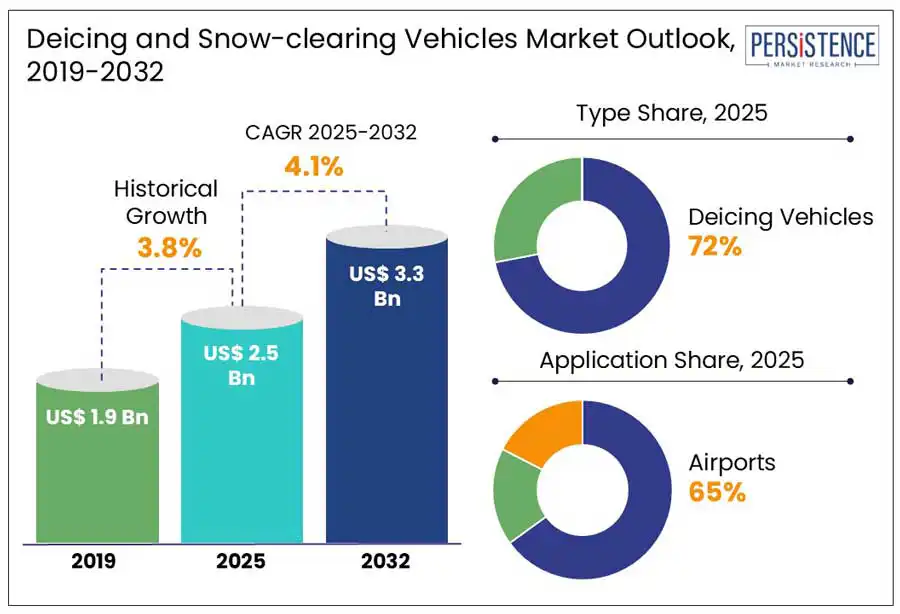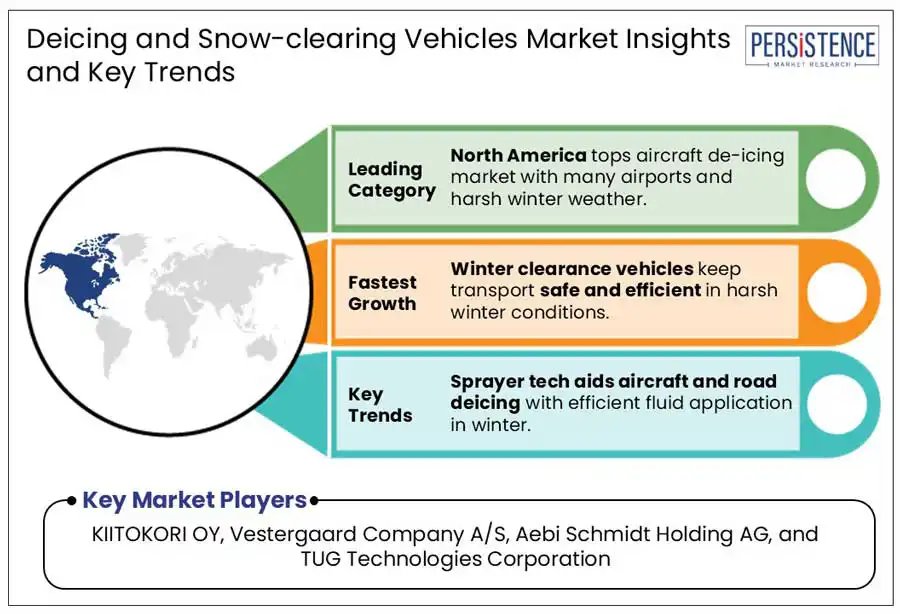Comprehensive Snapshot for Deicing and Snow-clearing Vehicles Market Including Regional and Country Analysis in Brief.
Industry: Automotive & Transportation
Published Date: April-2025
Format: PPT*, PDF, EXCEL
Delivery Timelines: Contact Sales
Number of Pages: 180
Report ID: PMRREP35219
The global deicing and snow-clearing vehicles market size is anticipated to rise from US$ 2.5 Bn in 2025 to US$ 3.3 Bn by 2032. It is projected to witness a CAGR of 4.1% from 2025 to 2032.
According to Persistence Market Research, the market for deicing and snow-clearing vehicles is expected to experience significant growth due to their crucial role in ensuring safe operations for aviation, roadways, and railways during winter. They prevent lift loss and engine failure in aviation, improve traction, and reduce hazards on highways and railways, which is essential for safe winter transportation. In many cold regions and countries, the government has to spend a significant amount of money to maintain roads, highways, and airports during winter. For instance, in the United States, approximately 20% of transportation maintenance budgets in cold states are allocated for winter road maintenance which is equivalent to US$ 2.3 billion every year.
Heavy snowfall at airports also results in long delays for airport operations. Some of the recent examples are,
These events highlight the need for effective deicing and snow-clearing vehicles to ensure safe and efficient transportation during harsh winter conditions.

Key Industry Highlights:
|
Global Market Attribute |
Key Insights |
|
Deicing and Snow-clearing Vehicles Market Size (2025E) |
US$ 2.5 Bn |
|
Market Value Forecast (2032F) |
US$ 3.3 Bn |
|
Projected Growth (CAGR 2025 to 2032) |
4.1% |
|
Historical Market Growth (CAGR 2019 to 2024) |
3.8% |
International aviation bodies such as the ICAO, the Federal Aviation Administration (FAA) in the United States, and the European Union Aviation Safety Agency (EASA) impose stringent de-icing requirements to ensure flight safety. According to 14 CFR-121.629, U.S. aircraft operators must ensure no aircraft takes off with frost, ice, or snow adhering to critical surfaces unless authorized procedures, such as de-icing or anti-icing are followed. These regulations require airplanes to be completely de-iced before departure to avoid ice accumulation, which can impair aerodynamics and cause accidents.
Compliance with these restrictions has resulted in greater investment in advanced de-icing technology and automobiles. Airports and airlines throughout the world are prioritizing efficient and environment-friendly de-icing technologies, fueling market growth as aviation authorities constantly update safety standards to reduce winter operation risks.
Snow-removal vehicle demand is largely seasonal, with peak sales happening in the winter and a significant fall during the warmer months. This cyclic nature creates challenges for manufacturers in maintaining steady revenue streams and efficient production cycles. Inventory management gets complicated as peak demand periods are followed by extended off-seasons. Furthermore, fleet operators and governments may postpone acquisitions and rely on existing equipment during mild winters. This volatility affects the investment challenging the business investments.
The adoption of electric de-icing trucks is growing at major airports as aviation players prioritize sustainability and cost-effectiveness. These vehicles offer lower emissions, reduced fuel dependency, and lower operational costs compared to traditional diesel-powered alternatives. With global attempts to attain carbon neutrality in aviation, regulatory organizations and airports are incentivizing the switch to environmentally friendly ground support equipment.
Winter clearance vehicles play an important role in maintaining transportation networks safe and efficient during harsh winter weather. These vehicles include snowplows, snow blowers, and sweepers, all of which are intended for specific duties. Snowplows clear accumulated snow off roads, runways, and trains, allowing vehicles and planes to travel freely. Snow blowers efficiently remove heavy snow by lifting and forcing it away from cleared surfaces, making them excellent for places with high snowfall. Sweepers aid in the removal of remaining snow and ice, hence enhancing traction and minimizing slip hazards. These vehicles are vital to maintaining continuous operations at airports, roadways, and other critical infrastructure.

North America leads the market for aircraft de-icing and snow-clearing vehicles due to its high concentration of airports and harsh winter conditions. According to the Federal Aviation Administration (FAA), as of 2024, the United States has approximately 19,633 airports, comprising 5,082 public airports and 14,551 private airports. In 2025, Quebec, Canada, experienced extreme cold, with temperatures dropping to -20°C and wind chills reaching a dangerous -50°C.
Frequent blizzards, ice storms, and freezing rain pose significant challenges to aviation, requiring advanced de-icing solutions for both aircraft and runways. Regulatory mandates from agencies like the FAA and Transport Canada further drive demand. As climate change increases weather unpredictability, the region continues investing in automated de-icing systems and eco-friendly de-icing technologies to enhance safety and efficiency.
Europe experiences frequent and intense snowfall during winter, significantly impacting road transportation. Countries such as Germany, the U.K., and France face disruptions as roads become heavily covered with snow, leading to hazardous driving conditions. In 2023, Germany recorded 4,535 road traffic accidents resulting in personal injury due to slippery conditions caused by snow or ice.
Governments and municipalities are increasingly investing in road snow removal vehicles such as snowplows, blowers, and salt spreaders to ensure smooth traffic flow and minimize accidents. With the rise in unpredictable winter storms due to climate change, the demand for advanced and efficient de-icing and snow-clearing equipment continues to grow, driving innovation and market expansion across the region for safer and more reliable road networks.
Asia Pacific is home to the world’s largest and most advanced high-speed rail networks, particularly in China, Japan, and South Korea. In 2023, China led Asia Pacific in railway coverage with 131,000 kilometers, followed by India with 68,000 kilometers.
These countries experience harsh winters with heavy snowfall, making de-icing and snow removal essential for ensuring uninterrupted railway operations. Snow accumulation on tracks, overhead lines, and signaling systems causes severe delays and safety risks. Governments and railway operators invest heavily in automated de-icing technologies, heated tracks, and specialized snow-clearing vehicles to maintain high-speed rail efficiency. With ongoing railway expansions, demand for innovative de-icing solutions in APAC continues to grow significantly.
The global de-icing and snow-clearing vehicle market is highly competitive, driven by innovation, sustainability, and efficiency. Leading companies are concentrating on creating innovative technologies, such as electric and self-driving vehicles, to improve performance and reduce environmental impact.
Manufacturers are introducing electric and hybrid de-icing vehicles to reduce carbon emissions, while autonomous and AI-driven systems are improving operational efficiency. Innovations in sensor-based de-icing systems enable precise fluid application, minimizing waste and environmental impact. Multi-functional vehicles capable of handling both de-icing and snow removal are being developed for enhanced adaptability. Government laws and infrastructure investments further impact market dynamics, encouraging businesses to embrace eco-friendly and high-performance solutions.
|
Report Attribute |
Details |
|
Historical Data/Actuals |
2019 - 2024 |
|
Forecast Period |
2025 - 2032 |
|
Market Analysis Units |
Value: US$ Bn/Bn, Volume: As applicable |
|
Geographical Coverage |
|
|
Segmental Coverage |
|
|
Competitive Analysis |
|
|
Report Highlights |
|
|
Customization and Pricing |
Available upon request |
By Type
By Application
By Technology
By Region
To know more about delivery timeline for this report Contact Sales

The Deicing and Snow-clearing Vehicles market is estimated to be valued at US$ 2.5 Bn in 2025.
International civil aviation organization (ICAO), and other regional aviation authorities mandate aircraft de-icing before take-off to prevent accidents is the key demand driver for deicing and snow-clearing vehicles market.
In 2025, North America region dominates the market with 20.1% share in the global Deicing and Snow-clearing Vehicles market.
Among application segment, demand from airports segment is expected to grow rapidly at 4.2% CAGR from 2025-2032.
KIITOKORI OY, Vestergaard Company A/S, Aebi Schmidt Holding AG, and TUG Technologies Corporation are the leading players in Deicing and Snow-clearing Vehicles market.